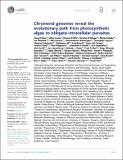Chromerid genomes reveal the evolutionary path from photosynthetic algae to obligate intracellular parasites

View/
Author
Woo, Yong H
Ansari, Hifzur
Otto, Thomas D
Klinger, Christen M
Kolisko, Martin
Michálek, Jan
Saxena, Alka
Shanmugam, Dhanasekaran
Tayyrov, Annageldi
Veluchamy, Alaguraj
Ali, Shahjahan
Bernal, Axel
del Campo, Javier
Cihlář, Jaromír
Flegontov, Pavel
Gornik, Sebastian G
Hajdušková, Eva
Horák, Aleš
Janouškovec, Jan
Katris, Nicholas J
Mast, Fred D
Miranda-Saavedra, Diego
Mourier, Tobias
Naeem, Raeece
Nair, Mridul
Panigrahi, Aswini K
Rawlings, Neil D
Padron-Regalado, Eriko
Ramaprasad, Abhinay
Samad, Nadira
Tomčala, Aleš
Wilkes, Jon
Doerig, Christian
Bowler, Chris
Keeling, Patrick J
Roos, David S
Dacks, Joel B
Templeton, Thomas J
Waller, Ross F
Lukeš, Julius
Oborník, Miroslav
Pain, Arnab
Note: Order does not necessarily reflect citation order of authors.
Published Version
https://doi.org/10.7554/eLife.06974Metadata
Show full item recordCitation
Woo, Y. H., H. Ansari, T. D. Otto, C. M. Klinger, M. Kolisko, J. Michálek, A. Saxena, et al. 2015. “Chromerid genomes reveal the evolutionary path from photosynthetic algae to obligate intracellular parasites.” eLife 4 (1): e06974. doi:10.7554/eLife.06974. http://dx.doi.org/10.7554/eLife.06974.Abstract
The eukaryotic phylum Apicomplexa encompasses thousands of obligate intracellular parasites of humans and animals with immense socio-economic and health impacts. We sequenced nuclear genomes of Chromera velia and Vitrella brassicaformis, free-living non-parasitic photosynthetic algae closely related to apicomplexans. Proteins from key metabolic pathways and from the endomembrane trafficking systems associated with a free-living lifestyle have been progressively and non-randomly lost during adaptation to parasitism. The free-living ancestor contained a broad repertoire of genes many of which were repurposed for parasitic processes, such as extracellular proteins, components of a motility apparatus, and DNA- and RNA-binding protein families. Based on transcriptome analyses across 36 environmental conditions, Chromera orthologs of apicomplexan invasion-related motility genes were co-regulated with genes encoding the flagellar apparatus, supporting the functional contribution of flagella to the evolution of invasion machinery. This study provides insights into how obligate parasites with diverse life strategies arose from a once free-living phototrophic marine alga. DOI: http://dx.doi.org/10.7554/eLife.06974.001Other Sources
http://www.ncbi.nlm.nih.gov/pmc/articles/PMC4501334/pdf/Terms of Use
This article is made available under the terms and conditions applicable to Other Posted Material, as set forth at http://nrs.harvard.edu/urn-3:HUL.InstRepos:dash.current.terms-of-use#LAACitable link to this page
http://nrs.harvard.edu/urn-3:HUL.InstRepos:17820731
Collections
- SPH Scholarly Articles [6362]
Contact administrator regarding this item (to report mistakes or request changes)


